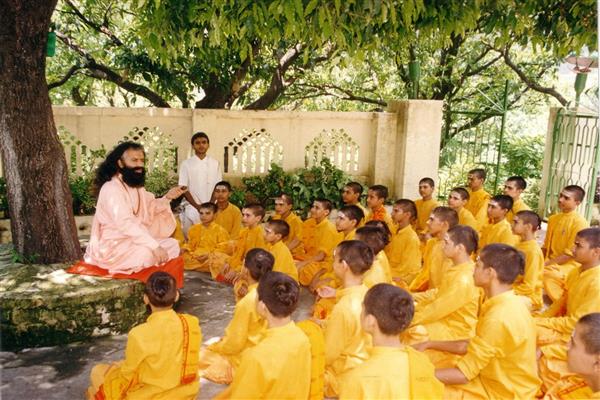Search here

11-Jun-2025 , Updated on 7/21/2025 7:00:25 AM
What Happened to India's Ancient Gurukul System?
The Gurukul system of ancient India used to be the foundation of the Indian education system based on the ideas of integrated education and spiritual growth. The Gurukul system stressed more on imparting knowledge through direct guidance between the guru (teacher) and shishya (student) usually in a natural environment free of the urban civilization. Emphasis was laid on Vedic knowledge, philosophy, mathematics, astronomy, warfare, arts and practical skills of life with a firm foundation on moral and ethical values. Nevertheless, this diverse and sensorial tradition of education suffered a severe decline with time because of various historical, social, and political reasons.
Invasive and Cultural Displacement
Repeated invasions first by the Islamic forces and then by the European colonizers were the first real jolt to the Gurukul system. Foreign rulers usually considered local educational traditions as unequal or unrelated to their ruling and administrative objectives. When the British came in the 18 th century, the traditional systems were deliberately marginalized as western patterns of learning were imported to India. Gurukuls, that failed to align with the British academic systems, lost state encouragement and funding, and their influence dwindled over time.
Imposition of Colonial Education
The notorious 1835 "Minute on Indian Education" by Lord Macaulay was central in revolutionizing the education in India. To groom a group of intermediaries who were “Indian in blood and color, but English in tastes, opinions, morals, and intellect”, the British set up English-language schools. It resulted in institutionalization of rote learning, tests and degree based education. With the spread of formal schools and colleges, Gurukuls which followed oral tradition and practical education were sidelined. Sanskrit, in which several of the Gurukul teaching were held, also became less relevant. Urbanization and modernization After independence, India emphasized on modernization and industrialization. The migration to urban areas and the increases demand of formal qualification saw the emergence of state-controlled schools, universities and technical institutions.
The Gurukul system with its years of intense study in rural or forest environments could not keep pace with the career driven and accelerated needs of contemporary living. The focus of the system on spiritual education and character-shaping appeared awkward in a competitive exam-oriented system. There was also the impact on Gurukul system of increasing alienation with the own heritage of India. The quest to acquire modernization saw the dismissal of the indigenous knowledge systems as being old fashioned or unscientific.
The old methods of learning were not accepted in formal schools and were not part of the mainstream programs. With time, the institutional support was absent, and with poor funding and dwindling attention of people, the true Gurukuls became extinct. Revival Efforts Even in modern times there have been attempts to reintroduce the Gurukul system in India, although it has been in decline. There are also a few spiritual and educational organizations like the Chinmaya Mission, Arya Samaj and Ramakrishna Mission that have founded modern Gurukuls that blend ancient curriculum with modern education. The National Education Policy (NEP) 2020 also supports the fact that traditional knowledge must be incorporated into the modern education system, as well as the study of Sanskrit and overall development.
Sequels and Contemporary Versions
It was not only a loss of educational order, but also cultural identity, old value system and a way of sustainable living that was experienced when the Gurukul system started to fade. Students did not just study scriptures and sciences but also led a disciplined life of service and simplicity in Gurukuls. Education was free and it was regarded as a religious obligation and not a business. The spiritual relationship of guru and shishya was built on the foundations of trust, humility and eternal learning- values almost absent in modern day transactional education system.
Late dissatisfaction with the rote-oriented, stress-intensive schooling system has led in recent years to new interest in alternative educational traditions. Certain teachers and parents are currently demanding models, which emphasize emotional intelligence, learning values, and a personal touch-features inherent in the time-tested Gurukul system. Schools based on the Gurukul ethos are beginning to emerge in India, Vedic studies are being integrated with modern science and technology and a concern about the environment.
In addition, online media is contributing to the visibility of the conventional Indian education. Sanskrit courses online, yoga teacher training qualifications and Vedic studies are becoming well-liked amongst Indian and foreign scholars.
A wider policy support, curriculum change and social acceptance is required to restore the Gurukul legacy and architecture in the true sense. Only closing the divide between tradition and modernity may result in the development of an educational system that is not just competitive, but also profound in terms of cultural wisdom.
Conclusion
The ancient Gurukul system which was the lamp of intellectual and spiritual education lost its shape under the burden of colonialism, modernization, and the change of values by the society. Nevertheless, its original values of personal mentorship, character formation, and the whole person education continue to find a chord today. When sensitively incorporated into the present-day paradigms, the insights of the Gurukul tradition can add values to the contemporary education system and can bring the future generations back to the cultural sources of India.

Individual / Self Employee
I’m Lakshya, a passionate content writer skilled in crafting engaging, SEO-friendly articles, blogs, and web content. I focus on clarity, creativity, and delivering value across diverse topics and industries.
Comments
Join Our Newsletter
Subscribe to our newsletter to receive emails about new views posts, releases and updates.
Copyright 2010 - 2025 MindStick Software Pvt. Ltd. All Rights Reserved Privacy Policy | Terms & Conditions | Cookie Policy